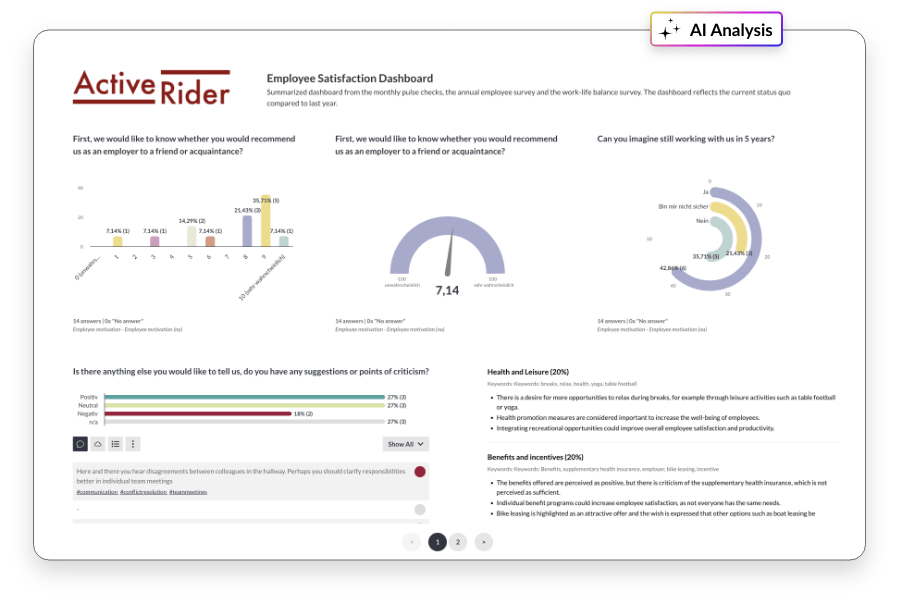Advantages of AI-supported survey analysis
1st advantage: Speed and efficiency
Traditional analyses take a lot of time: tables have to be filtered, cross-comparisons created and comments read and categorized.
AI-based analysis tools take this work off the user’s hands.
They analyze thousands of responses in a matter of seconds and provide ready-made interpretations – not only based on numbers, but also on content.

Example: While a team without AI would spend days analyzing the results of an employee survey, an AI-supported solution provides a well-founded summary with clear recommendations for action within a few seconds.
2nd advantage: Automatic categorization of free text answers
Open questions often provide the most valuable insights – but they are difficult to evaluate.
AI algorithms can semantically analyze these texts, recognize recurring themes and automatically sort them into categories.
This not only searches for keywords, but also understands the meaning of the text in context.
Added value: This enables a structured evaluation of open fields that are otherwise often only considered superficially or completely neglected. In addition, the AI can also recognize the tonality of the responses (positive, negative, neutral) - a decisive advantage when it comes to customer or employee feedback.
3rd advantage: objectivity and consistency
Human interpretations are naturally subjective.
Two analysts can evaluate the same text differently, especially with open answers.
An AI, on the other hand, evaluates similar answers consistently according to the same rules – this ensures greater objectivity and comparability, especially in the case of recurring surveys or benchmarks.
Wichtig: Konsistenz erhöht nicht nur die Genauigkeit, sondern stärkt auch die Glaubwürdigkeit der Auswertung gegenüber Stakeholdern.
4th advantage: Deep insights through pattern recognition
One of the greatest strengths of AI systems is their ability to recognize complex relationships and patterns that a human would miss at first glance.

For example:
- Is there a correlation between satisfaction in a particular area of the company and staff turnover?
- Which demographic groups are particularly critical?
AI recognizes such correlations without having to form hypotheses beforehand.
The result: Companies not only receive answers, but also new questions and hypotheses - a decisive step towards forward-looking management and strategic planning.
The Result Studio – AI meets user-friendliness
With the Result Studio, we offer a tool that makes access to AI-supported analysis particularly easy – without any programming knowledge or external data scientists.

It combines state-of-the-art analysis technology with an intuitive user interface.
Functions at a glance:
- Intelligent summaries of results: The AI automatically summarizes the most important findings of the survey in understandable natural language – ideal for reports or presentations.
- Topic and sentiment analysis: Open responses are clustered thematically. At the same time, the AI recognizes whether an answer is formulated positively, negatively or neutrally.
- Individual filters and evaluations: Users can view and analyze specific target groups, regions or time periods – without technical hurdles.
- Visual presentation: Results are presented clearly and interactively – from diagrams to dynamic response distributions.
- Data protection compliance: As a German company, easyfeedback meets the highest GDPR standards – a decisive advantage over many international providers.
Conclusion: AI + Result Studio = smart basis for decision-making
Analyzing surveys is not only faster with AI – it is also deeper, more structured and more meaningful. Where gut feeling used to dominate, AI-supported systems deliver reliable findings.
With our Result STUDIO, this technology is also accessible to non-technicians – simple, intuitive and powerful.
If you want to get more out of your surveys – whether for HR, marketing, customer satisfaction or product development – Result Studio is a future-proof tool that rethinks analysis.
Because data-based decisions don’t start with the survey – they start with the right analysis.




